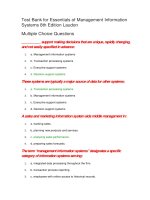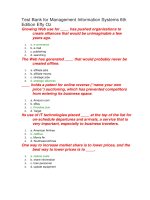Enterprise manage information systems 6th by laudon ch11
Bạn đang xem bản rút gọn của tài liệu. Xem và tải ngay bản đầy đủ của tài liệu tại đây (874.46 KB, 52 trang )
Chapter 11
Essentials of Management Information Systems, 6e
Chapter 11 Managing Knowledge in the Digital Firm
Managing Knowledge in
the Digital Firm
11.1
© 2005 by Prentice Hall
Essentials of Management Information Systems, 6e
Chapter 11 Managing Knowledge in the Digital Firm
Objectives
1. What is knowledge management? Why do
businesses today need knowledge
management programs and systems for
knowledge management?
2. What types of systems are used for enterprisewide knowledge management? How do they
provide value for organizations?
3. How do knowledge work systems provide value
for firms? What are the major types of
knowledge work systems?
11.2
© 2005 by Prentice Hall
Essentials of Management Information Systems, 6e
Chapter 11 Managing Knowledge in the Digital Firm
Objectives
4. What are the business benefits of using
intelligent techniques for knowledge
management?
5. What major management issues and
problems are raised by knowledge
management systems? How can firms
obtain value from their investments in
knowledge management systems?
11.3
© 2005 by Prentice Hall
Essentials of Management Information Systems, 6e
Chapter 11 Managing Knowledge in the Digital Firm
Management Challenges
1. Designing knowledge systems that
genuinely enhance organizational
performance
2. Identifying and implementing
appropriate organizational applications
for artificial intelligence
11.4
© 2005 by Prentice Hall
Essentials of Management Information Systems, 6e
Chapter 11 Managing Knowledge in the Digital Firm
The Knowledge Management Landscape
Important Dimensions of Knowledge
11.5
•
Knowledge
•
Wisdom
•
Tacit knowledge
•
Explicit knowledge
© 2005 by Prentice Hall
Essentials of Management Information Systems, 6e
Chapter 11 Managing Knowledge in the Digital Firm
The Knowledge Management Landscape
U.S enterprise knowledge management software revenues, 2001-2006
Figure 11-1
11.6
© 2005 by Prentice Hall
Essentials of Management Information Systems, 6e
Chapter 11 Managing Knowledge in the Digital Firm
The Knowledge Management Landscape
Important Dimensions of Knowledge
•
11.7
Knowledge:
– Is a firm asset
– Has different forms
– Has a location
– Is situational
© 2005 by Prentice Hall
Essentials of Management Information Systems, 6e
Chapter 11 Managing Knowledge in the Digital Firm
The Knowledge Management Landscape
Organizational Learning and Knowledge Management
11.8
•
Organizational learning: Creation of
new standard operating procedures
and business processes reflecting
experience
•
Knowledge management: Set of
processes developed in an
organization to create, gather, store,
disseminate, and apply knowledge
© 2005 by Prentice Hall
Essentials of Management Information Systems, 6e
Chapter 11 Managing Knowledge in the Digital Firm
The Knowledge Management Landscape
The knowledge management value chain
Figure 11-2
11.9
© 2005 by Prentice Hall
Essentials of Management Information Systems, 6e
Chapter 11 Managing Knowledge in the Digital Firm
The Knowledge Management Landscape
The Knowledge Management Value Chain
11.10
•
Knowledge acquisition
•
Knowledge storage
•
Knowledge dissemination
•
Knowledge application
© 2005 by Prentice Hall
Essentials of Management Information Systems, 6e
Chapter 11 Managing Knowledge in the Digital Firm
The Knowledge Management Landscape
The Knowledge Management Value Chain
11.11
•
Chief Knowledge Officer (CKO):
Senior executive in charge of the
organization's knowledge
management program
•
Communities of Practice (COP):
Informal groups who may live or
work in different locations but share
a common profession
© 2005 by Prentice Hall
Essentials of Management Information Systems, 6e
Chapter 11 Managing Knowledge in the Digital Firm
Types of Knowledge Management Systems
Types of Knowledge Management Systems
11.12
•
Enterprise Knowledge Management Systems:
General purpose, integrated, and firm-wide systems
to collect, store and disseminate digital content and
knowledge
•
Knowledge Work Systems (KWS): Information
systems that aid knowledge workers in the creation
and integration of new knowledge in the organization
•
Intelligent Techniques: Datamining and artificial
intelligence technologies used for discovering,
codifying, storing, and extending knowledge
© 2005 by Prentice Hall
Essentials of Management Information Systems, 6e
Chapter 11 Managing Knowledge in the Digital Firm
Types of Knowledge Management Systems
Major types of knowledge management systems
Figure 11-3
11.13
© 2005 by Prentice Hall
Essentials of Management Information Systems, 6e
Chapter 11 Managing Knowledge in the Digital Firm
Enterprise-Wide Knowledge Management Systems
Structured Knowledge Systems
11.14
•
Structured knowledge
•
Semistructured knowledge
•
Knowledge repository
•
Knowledge network
© 2005 by Prentice Hall
Essentials of Management Information Systems, 6e
Chapter 11 Managing Knowledge in the Digital Firm
Enterprise-Wide Knowledge Management Systems
Enterprise-wide knowledge management systems
Figure 11-4
11.15
© 2005 by Prentice Hall
Essentials of Management Information Systems, 6e
Chapter 11 Managing Knowledge in the Digital Firm
Enterprise-Wide Knowledge Management Systems
KWorld’s knowledge domain
Figure 11-5
11.16
© 2005 by Prentice Hall
Essentials of Management Information Systems, 6e
Chapter 11 Managing Knowledge in the Digital Firm
Enterprise-Wide Knowledge Management Systems
KPMG knowledge system processes
Figure 11-6
11.17
© 2005 by Prentice Hall
Essentials of Management Information Systems, 6e
Chapter 11 Managing Knowledge in the Digital Firm
Enterprise-Wide Knowledge Management Systems
Window on Technology
DaimlerChrysler Learns to Manage
Its Digital Assets
11.18
•
What are the management benefits
of using a digital asset management
system?
•
How does ADAM provide value for
DaimlerChrysler?
© 2005 by Prentice Hall
Essentials of Management Information Systems, 6e
Chapter 11 Managing Knowledge in the Digital Firm
Enterprise-Wide Knowledge Management Systems
Organizing Knowledge: Taxonomies and Tagging
11.19
•
Taxonomy: Method of classifying
things according to a predetermined
system
•
Tagging: Once a knowledge
taxonomy is produced, documents
are tagged with proper classification
© 2005 by Prentice Hall
Essentials of Management Information Systems, 6e
Chapter 11 Managing Knowledge in the Digital Firm
Enterprise-Wide Knowledge Management Systems
Hummingbird’s integrated knowledge management system
Figure 11-7
11.20
© 2005 by Prentice Hall
Essentials of Management Information Systems, 6e
Chapter 11 Managing Knowledge in the Digital Firm
Enterprise-Wide Knowledge Management Systems
Knowledge Networks
Key Functions of an Enterprise Knowledge Network
11.21
•
Knowledge exchange services
•
Community of practice support
•
Auto-Profiling Capabilities
•
Knowledge management services
© 2005 by Prentice Hall
Essentials of Management Information Systems, 6e
Chapter 11 Managing Knowledge in the Digital Firm
Enterprise-Wide Knowledge Management Systems
The problem of distributed knowledge
Figure 11-8
11.22
© 2005 by Prentice Hall
Essentials of Management Information Systems, 6e
Chapter 11 Managing Knowledge in the Digital Firm
Enterprise-Wide Knowledge Management Systems
AskMe Enterprise knowledge network system
Figure 11-9
11.23
© 2005 by Prentice Hall
Essentials of Management Information Systems, 6e
Chapter 11 Managing Knowledge in the Digital Firm
Enterprise-Wide Knowledge Management Systems
Portals, Collaboration Tools, and Learning Management Systems
•
11.24
Teamware: Group collaboration
software running on intranets that is
customized for teamwork
© 2005 by Prentice Hall
Essentials of Management Information Systems, 6e
Chapter 11 Managing Knowledge in the Digital Firm
Enterprise-Wide Knowledge Management Systems
Portals, Collaboration Tools, and Learning Management Systems
•
11.25
Learning Management Systems
(LMS): Tools for the management,
delivery, tracking, and assessment
of various types of employee
learning
© 2005 by Prentice Hall









